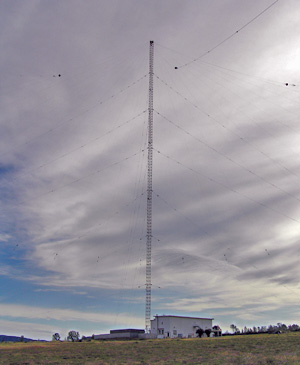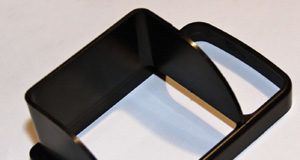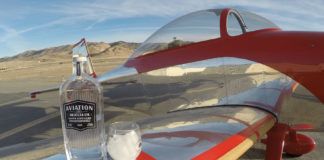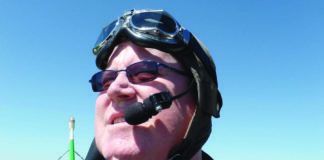Every now and again I’ll get a question that “everybody knows the answer to” and yet nobody actually seems to. In this particular case, a homebuilder said he wanted to put antennas on his airplane for every possible frequency that was permitted for aviation. How would he go about doing that?

The 700-foot tall loran tower from the Middletown loran station near Clear Lake in Northern California. Even at this height the antenna is nowhere near a quarter wave, so it must be electrically tricked into thinking it is this long with loading coils at the base of the antenna.
Wow. Every one, huh? My answer was that it wasn’t really possible unless he was homebuilding something on the order of a C-130. He didn’t understand until I had him download 47CFR87 (Title 47 of the Code of Federal Regulations, Part 87), in which the FCC (not the FAA) outlines exactly what frequencies are allocated to the aviation services. Let’s take a look at the entire aviation spectrum proceeding from low to high frequencies (long wavelengths to short wavelengths). Regarding wavelengths, we want to make antennas a quarter wavelength long, so after each frequency I’m going to give you the wavelength of a quarter wave in inches. For example, the VHF com band is centered at 127 megahertz (MHz), so I’ll give you this answer: 127 MHz (23.25 inches). If you want to do your own calculation, one quarter wave in inches equals 2953 divided by frequency (in MHz). Also, don’t forget that there are 1000 kilo-hertz (kHz) in 1 MHz and 1000 MHz in one gigahertz (GHz).
100 kHz Through 30 MHz
1) 100 kHz (29,527 inches or about 2461 feet): This is the recently departed loran frequency.
2) 190 to 285 kHz, 325 to 435 kHz, 510 to 525 kHz (14,750 inches to 7108 inches): This is the non-directional beacon (NDB) band, sometimes called the ADF band. Most ADF receivers will also receive the commercial AM broadcast band 535 to 1700 kHz.
3) 3 to 30 MHz (3937 inches to 394 inches): At this point things start to get goosey. This so-called “HF” band is where all aircraft communications once took place, though by 1950 most aircraft vacated the HF band for the more compact and reliable VHF band. However, because radio waves below 30 MHz can generally be used for ultra-long distance communications (because radio signals below 30 MHz can be bounced multiple times off ionospheric layers at very high altitudes above the surface), most transoceanic aircraft use these frequencies for communicating with land stations.
Given the relative ease of communicating via satellite, the HF band will probably go the way of the loran band in the next few years. Meanwhile, the following aviation HF bands still exist (all in MHz): 2.85 to 3.15, 3.40 to 3.50, 4.65 to 4.75, 5.45 to 5.75, 6.50 to 6.80, 8.80 to 9, 10.005 to 10.010, 11.17 to 11.40, 13.20 to 13.35, 15.01 to 15.10, 17.90 to 18, 21.80 to 22, 21.964 (Pacific Ocean), and 22.75 to 24.90.

Each of the little slots in this X-band weather radar antenna is actually a half-wave antenna and is approximately 0.6 inches long. The little half wave slot antennas combine to focus a pinpoint beam of energy from the face of the antenna. The antenna is on a swivel that allows the beam to be swept across the nose of the aircraft from left to right and positioned up or down depending on what part of the sky the pilot wants to view.
75 MHz Through 157.425 MHz
4) 75 MHz (39.3 inches): outer, middle and inner marker beacons; 400 Hz audio tone for outer, 1300 Hz tone for middle and 3000 Hz tone for inner (blue, orange and white lights, respectively).
5) 108 and 108.1 MHz (27.2 inches): VOR test and LOC test, respectively.
6) 108.2 to 111.8 MHz (26.8 inches): VOR on even tenth frequencies only (108, 108.2, 108.4 and so on).
7) 108.3 to 111.9 MHz (26.8 inches): ILS localizer on odd tenth frequencies only (108.1, 108.3, 108.5 and so on). See comment under no. 14, glideslope channels.
8) 112 to 117.95 MHz (26.1 inches): VOR on all channels (50 kHz spacing) in this band. However, there are very few VORs on the split channel (50 kHz frequencies).
9) 118 to 136.975 MHz (23.3 inches): VHF com band, AM double sideband full carrier. A few chosen frequencies: 121.5 emergency and ELT; 122.0 flight watch (weather only); 122.75 the only channel legally authorized for fixed-wing air-to-air (chatter); 123.1 for rotary wing chatter; 123.1 is limited to search and rescue missions (122.9 is used for practice missions).
10) 123.125 to 123.575, including the infamous 123.4 and 123.45 are flight test stations only, with a specific license required for both aircraft and ground stations on these frequencies, no matter what your good buddy in the next hangar told you. Also from this band, 123.3 and 123.5 may be issued to flight schools, individual flight instructors, gliders and free balloons in flight instruction use.
11) 136 to 137 were supposed to have been reserved to relieve the “unicom squeal” at smaller airports, but only five channels out of 40 were ultimately reserved. These five channels also can be used for automated weather (AWOS).
156.3 MHz Through 12,500 MHz
12) 156.3 to 157.425 MHz (18.8 inches): Several channels in this band are reserved for aircraft/ship communications with the provision that the aircraft must be below 1000 feet AGL at the time of use.
13) 243 MHz (12.2 inches): UHF emergency frequency and ELT.
14) 328.6 to 335.4 MHz (8.9 inches): glideslope channels paired with localizer frequencies. There is neither rhyme nor reason (nor mathematical relationship) between a localizer frequency and its glideslope pairing. In today’s electronic chip memory that isn’t a real problem, but back in the days when we had to use tubes it was a royal pain in the labonza.
15) 1030 and 1090 MHz. (2.8 inches): The aircraft’s transponder transmits a pulse train at 1090 MHz in response to the ground radar interrogating the aircraft on 1030 MHz.
16) 962 to 1213 MHz (2.7 inches): The distance measuring equipment (DME) band. Once again, paired with the associated VOR/LOC frequency. At least there is some logic and thought behind the pairing. The airborne transmitter goes from 1041 MHz (paired with 108) to 1150 MHz (paired with 117.9). It is a real neat progression of a 1 MHz step in DME frequency with a 0.1 step in VOR/LOC frequency, but there is a hiccup at 112.3 MHz where the DME frequency suddenly takes a 10-MHz jump. Sigh. Somebody in the FCC/FAA just has it in for avionics engineers. And the ground station replies on 978 MHz (108 VOR) to 1213 MHz (117.9 VOR). Just like the aircraft transmitter, it progresses in a nice, linear fashion until you get to 112.3—where you’d expect a 10 MHz jump, there is a 37 MHz jump.
17) 4200 to 4400 MHz or 4.2 to 4.4 GHz (0.7 inches): radar altimeter band.
18) 8000 to 12,500 MHz (very short): Most civilian airborne weather radar operates in this “X” band frequency range on several assigned discrete frequencies. There are still a few of the older “C” band weather radars in existence that work around 5 GHz (5000 MHz).
And the poor guy wanted antennas on his airplane for all these frequencies. Isn’t going to happen, is it? In upcoming columns I’ve promised more computer sites for aviation—in particular how to navigate the FAA site. I’ll also have a few more computer tricks, and then we’ll get back into bits-and-pieces avionics. Until then, stay tuned.













